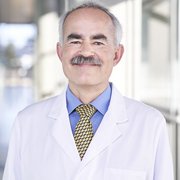- internistic

Prof. Dr. med. Thomas Seufferlein
Ärztlicher Direktor der Klinik für Innere Medizin I (Speiseröhre, Magen, Darm, Leber und Niere sowie Stoffwechselerkrankungen) und Sprecher des Darmzentrums

Dr. med. Thomas J. Ettrich
Oberarzt, Leiter Schwerpunkt GI-Onkologie, Leiter des klinischen Studienzentrums GI-Onkologie
Schwerpunkte
Gastrointestinale Onkologie, Klinische Studien

Dr. med. Angelika Kestler
Funktionsoberärztin, Fachärztin für Innere Medizin und Gastroenterologie, Palliativmedizin, Ärztliche Referentin für GI-Onkologie am CCCU
Schwerpunkte
Gastrointestinale Onkologie, Privatambulanz Prof. Seufferlein
- Surgical
- radiooncological
Description of the disease
Stomach cancer is a malignant neoplasm of certain cells in the stomach. In 95 per cent of cases, the glandular cells that produce gastric juice are affected (adenocarcinoma). Very rarely, lymphatic cells (lymphoma) or cells of muscle or connective tissue (sarcoma) degenerate.
Frequency and age of onset

The number of new cases of gastric carcinoma has fallen significantly in western industrialised nations over the last 50 years, but it is still one of the most common causes of tumour-related death worldwide. In terms of gender distribution, men are twice as likely as women to develop a malignant stomach tumour. The peak incidence for both sexes is between the ages of 60 and 80. While the incidence of distal gastric carcinomas (at the outlet of the stomach) has decreased significantly, there has been an increase in carcinomas of the cardia (entrance to the stomach) and the transition from the oesophagus to the stomach over the last 20 years (see Fig. 1).
Causes and risk factors
The causes for the development of gastric carcinoma are still unclear in detail.
Chronic alcohol and nicotine consumption, chronic Helicobacter pylori infection and dietary habits, such as the consumption of smoked or salted foods containing nitrates, are considered exogenous (caused by external factors) risk factors.
Endogenous risk factors are adenomatous gastric polyps (1-2% of all polypoid gastric mucosal lesions), chronic atrophic gastritis (inflammation of the gastric mucosa) type A (pernicious anaemia), Menetrier's disease (giant fold gastritis), gastric ulcers, previous stomach surgery and genetic factors (blood group A, familial gastric carcinomas).
Signs of illness
Symptoms of gastric carcinoma usually only occur in the advanced stages of the disease in the form of uncharacteristic upper abdominal complaints (loss of appetite, feeling of fullness, bad breath, vomiting, stomach pain, etc.), as well as weight loss and poor performance or symptoms of gastric bleeding (tarry stools = black stools, vomiting blood).
Weitere Informationen: www.krebsinformationsdienst.de/magenkrebs

